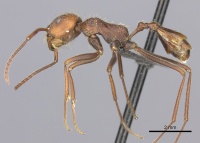Ocymyrmex sobek
| Ocymyrmex sobek | |
|---|---|

| |
| Scientific classification | |
| Kingdom: | Animalia |
| Phylum: | Arthropoda |
| Class: | Insecta |
| Order: | Hymenoptera |
| Family: | Formicidae |
| Subfamily: | Myrmicinae |
| Tribe: | Crematogastrini |
| Genus: | Ocymyrmex |
| Species: | O. sobek |
| Binomial name | |
| Ocymyrmex sobek Bolton, 1981 | |
Nothing is known about the biology of Ocymyrmex sobek.
Identification
A member of the weitzeckeri group. This strongly sculptured and conspicuously coloured species is closest related to Ocymyrmex foreli. Among the species with a clypeal impression and a distinctly constricted first gastral segment only two, sobek and foreli, have the petiole much enlarged and very strongly sculptured. The two are best separated on their colour but it is also notable that the rugae on the petiole node are narrower and more sharply defined in foreli than in sobek, where they tend to be blunted and much less regular on the dorsum. (Bolton 1981)
Keys including this Species
Distribution
Latitudinal Distribution Pattern
Latitudinal Range: -17.83333° to -25.71256°.
| North Temperate |
North Subtropical |
Tropical | South Subtropical |
South Temperate |
- Source: AntMaps
Distribution based on Regional Taxon Lists
Afrotropical Region: Botswana (type locality), South Africa, Zimbabwe.
Distribution based on AntMaps
Distribution based on AntWeb specimens
Check data from AntWeb
Countries Occupied
| Number of countries occupied by this species based on AntWiki Regional Taxon Lists. In general, fewer countries occupied indicates a narrower range, while more countries indicates a more widespread species. |

|
Estimated Abundance
| Relative abundance based on number of AntMaps records per species (this species within the purple bar). Fewer records (to the left) indicates a less abundant/encountered species while more records (to the right) indicates more abundant/encountered species. |

|
Biology
|
Castes
Worker
Images from AntWeb
   
| |
| Holotype of Ocymyrmex sobek. Worker. Specimen code casent0900403. Photographer Ryan Perry, uploaded by California Academy of Sciences. | Owned by NHMUK, London, UK. |
Nomenclature
The following information is derived from Barry Bolton's Online Catalogue of the Ants of the World.
- sobek. Ocymyrmex sobek Bolton, 1981b: 277, fig. 20 (w.q.) BOTSWANA.
Unless otherwise noted the text for the remainder of this section is reported from the publication that includes the original description.
Description
Worker
Holotype. TL 7.8, HL 1.90, HW 1.82, CI 96, SL 1.70, SI 93, PW 1.18, AL 2.44.
Anterior clypeal margin with a conspicuous median semicircular impression which is flanked by a pair of small teeth. Occipital margin in full-face view feebly indented medially, the margin continuous with the sides through a broad, shallow curve. Maximum diameter of eye 0.40, about 0.22 x HW. Promesonotum in profile evenly convex, the dorsum of the propodeum rounding broadly and evenly into the declivity. Metapleural lobes small, subtriangular in shape, but plainly visible in profile and not concealed by the bulge of the metapleural glands. Ventral surface of peduncle of petiole without a projecting process, the node strongly swollen and conspicuous. In profile the large node with a developed posterodorsal angle, not rounded as is usual in the genus. In dorsal view the petiole node massive, almost as large as the post petiole ; the latter also somewhat swollen, about as high as long in profile and broader than long in dorsal view. Base of first gastral tergite constricted, in dorsal view forming a neck behind the postpetiole which is narrower than the maximum width of the postpetiole itself. Dorsum of head finely and densely costulate to rugulose, the sculpture most regular on the central strip of the dorsum. On each side of this central strip the rugulae more wavy and irregular, and tending to diverge posteriorly towards the occipital corners, arching round above the eyes. Spaces between the rugulae with fine dense punctulate ground sculpture. Anterior portion of pronotum with arched-transverse rugae, behind this with an area where the rugae are almost longitudinal, very slightly oblique, running back between the mesothoracic spiracles; remainder of dorsum and also propodeal declivity coarsely transversely rugose. Sides of alitrunk coarsely rugose. Node of petiole coarsely rugose, the rugae continuous, running transversely on the ventral surface, up the sides of the node and across the dorsum; on the dorsum less regular than elsewhere. Anterior face of node and dorsum of peduncle in front of node also transversely rugose. Postpetiole unsculptured except for fine superficial shagreening. Dorsal surfaces of head, alitrunk and pedicel segments with numerous strong hairs. First gastral tergite with hairs much shorter and sparser than elsewhere. Alitrunk dull reddish black (appearing black to the naked eye); gaster dull yellowish red, much lighter than the alitrunk and contrasting strongly with it; head a dull red intermediate in shade between gaster and alitrunk so that the ant appears tricoloured to the naked eye.
Paratypes. TL 7.6-8.0, HL 1.70-1.90, HW 1.64-1.88, CI 93-100, SL 1.56-1.74, SI 92-99, PW 1.08-1.20, AL 2.20-2.44 (11 measured). Maximum diameter of eye 0.36-0.40, about 0.22-0.24 x HW. Answering description of holotype but some with the posterodorsal angle of the petiole more rounded and the pronotal sculpture showing the usual variation, with differences in extent and direction of the longitudinal component. In most the longitudinal rugae are antero-posteriorly straight, but in some (as in the holotype) they are oblique and in a few decidedly transverse. Sculpture pattern on the dorsum of the head is usually as described above but in a few the rugulae run straight back everywhere, not diverging towards the occipital corners, and in one the rugulae between the eye and the central strip of the head are more or less all transverse.
Size range in the non-paratypic material is TL 7.6-8.8, HL 1.80-2.00, HW 1.70-1.96, CI 93-98, SL 1.64-1.80, SI 91-98, PW 1.12-1.28, AL 2.24-2.52 (15 measured). Measurements of eyes all fall within the range of the paratype-series.
Type Material
Holotype worker, Botswana: Smiti, no. 16, mopane woodland, 11.ix.1975 (A. Russell-Smith) (The Natural History Museum). Paratypes. 11 workers with same data as holotype (BMNH, Museum of Comparative Zoology, Naturhistorisches Museum, Basel, Musee d'Histoire Naturelle Genève, NM, Bulawayo).
References
- Bolton, B. 1981. A revision of six minor genera of Myrmicinae (Hymenoptera: Formicidae) in the Ethiopian zoogeographical region. Bulletin of the British Museum (Natural History) Entomology. 43:245-307. (page 277, fig. 20 worker, queen described)
- Bolton, B. and A. C. Marsh. 1989. The Afrotropical thermophilic ant genus Ocymyrmex (Hymenoptera: Formicidae). Journal of Natural History. 23:1267-1308.
References based on Global Ant Biodiversity Informatics
- Bolton B. 1981. A revision of six minor genera of Myrmicinae (Hymenoptera: Formicidae) in the Ethiopian zoogeographical region. Bulletin of the British Museum (Natural History). Entomology 43: 245-307.
- Bolton B., and A. C. Marsh. 1989. The Afrotropical thermophilic ant genus Ocymyrmex (Hymenoptera: Formicidae). Journal of Natural History 23: 1267-1308.
- IZIKO South Africa Museum Collection

